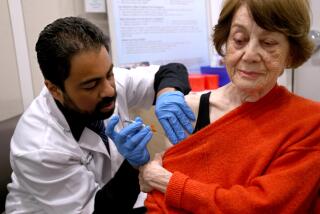California flu season could be one of the worst in a decade, state officials say
- Share via
California health officials said Tuesday that the state’s flu season could turn out to be one of the nastiest the state has seen in a long time.
“This appears to be one of the worst seasons we’ve had in the last 10 years,” state epidemiologist Dr. Gil Chavez said in a call with reporters. “We’re early, and we’re trending up.”
Most people in California and nationwide are catching a strain of influenza A known as H3N2, which tends to be deadlier than other strains. H3N2 was the culprit in Australia’s most recent flu season, which led to record numbers of sick people as well as well as the nickname “Aussie flu.”
Since the flu season in California began in October, 27 people under the age of 65 in California have died, compared with three or four at the same time in previous years. The state only collects data on deaths among people under 65; the actual death toll from the flu is much higher.
Among people of all ages, 33 people have died in L.A. County this flu season and 91 in San Diego County, officials say. Flu activity this winter began in Southern California and then spread north, state officials said.
It’s possible that this flu season won’t be especially bad and is just peaking early, said Dr. James Watt, chief of the division of communicable disease control with the California Department of Public Health. The flu season, which runs from October to May, typically reaches its height in February but can do so anytime during the season.
“Our hope is that because we started early, we’ll end early,” Watt said.
But it’s difficult to know for sure, so officials are recommending a flu shot for everyone over 6 months old. Experts say the flu shot may only be 30% effective this year, but can reduce the severity of symptoms for people who still get the flu. It takes about two weeks for the flu shot to take effect.
Among the 27 Californians under 65 who have died from the flu, 30% had been vaccinated against the flu, Chavez said. It’s possible they had other underlying health conditions, but officials haven’t yet analyzed the data.
In recent weeks, patients in California have struggled to get appointments at clinics and emergency room wait times have grown as people seek treatment for the flu. Doctors have reported shortages of flu medications, flu testing kits as well as flu shots at pharmacies.
Dr. Jeffrey Gunzenhauser, L.A. County’s interim health officer, said he started hearing about people having trouble finding the antiviral medication oseltamivir, known by the brand name Tamiflu, in December. The medication, which shortens the length of the illness, is often prescribed to people who are at high risk of complications from the flu, like pregnant women and the elderly.
“When I hear it’s not available, ‘I’m like, ‘Why not?’” Gunzenhauser said.
State health officials said Tuesday that they’d been talking to federal health officials about the problem.
“We are assured there’s no shortage of antiviral, it’s just that distribution hasn’t quite kept up with demand in some areas,” Chavez said.
Jim Negrete, pharmacist and owner of B&B Pharmacy in Yorba Linda, said he’s sold Tamiflu to 200 patients this flu season, compared to 10 in a typical season. Calls started coming in late last week and demand has only increased since.
“It’s just going straight up,” he said.
Hospitals, clinics and other pharmacies that have run out of the medicine have been referring patients to him, Negrete said. He also said that more people also began requesting flu shots this week, which is unusual for this late in the flu season.
“I just got some more in stock -- we ran out,” he said.
Twitter: @skarlamangla
ALSO
Severe flu brings medicine shortages, packed ERs and a rising death toll in California
In this deadly flu season, here are tips on how to protect yourself
More to Read
Sign up for Essential California
The most important California stories and recommendations in your inbox every morning.
You may occasionally receive promotional content from the Los Angeles Times.











